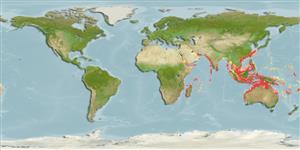Actinopterygii (ray-finned fishes) >
Perciformes (Perch-likes) >
Carangidae (Jacks and pompanos) > Caranginae
Etymology: Uraspis: Greek, oura = tail + Greek, aspis = shield (Ref. 45335).
Environment / Climate / Range
Ecology
Marine; reef-associated; depth range 20 - 130 m (Ref. 58302). Deep-water, preferred ?; 30°N - 36°S, 22°E - 154°W
Indo-West Pacific: Red Sea and the Persian Gulf eastward to Sri Lanka; then from India to the Philippines and Oahu, Hawaii, north to the Ryukyu Islands (Ref. 559), south to northern Australia. Recently recorded from Reunion (Ref. 53568).
Size / Weight / Age
Maturity: Lm ? range ? - ? cm
Max length : 28.0 cm FL male/unsexed; (Ref. 3287)
Adults occur in the continental shelf (Ref. 7300). They form schools in depths from 50 to at least 130 m. They feed on epibenthic crustaceans and cephalopods (Ref. 37816).
Life cycle and mating behavior
Maturity | Reproduction | Spawning | Eggs | Fecundity | Larvae
Paxton, J.R., D.F. Hoese, G.R. Allen and J.E. Hanley, 1989. Pisces. Petromyzontidae to Carangidae. Zoological Catalogue of Australia, Vol. 7. Australian Government Publishing Service, Canberra, 665 p. (Ref. 7300)
IUCN Red List Status (Ref. 115185)
CITES (Ref. 94142)
Not Evaluated
Threat to humans
Harmless
Human uses
Fisheries: minor commercial
More information
Common namesSynonymsMetabolismPredatorsEcotoxicologyReproductionMaturitySpawningFecundityEggsEgg development
ReferencesAquacultureAquaculture profileStrainsGeneticsAllele frequenciesHeritabilityDiseasesProcessingMass conversion
Tools
Special reports
Download XML
Internet sources
